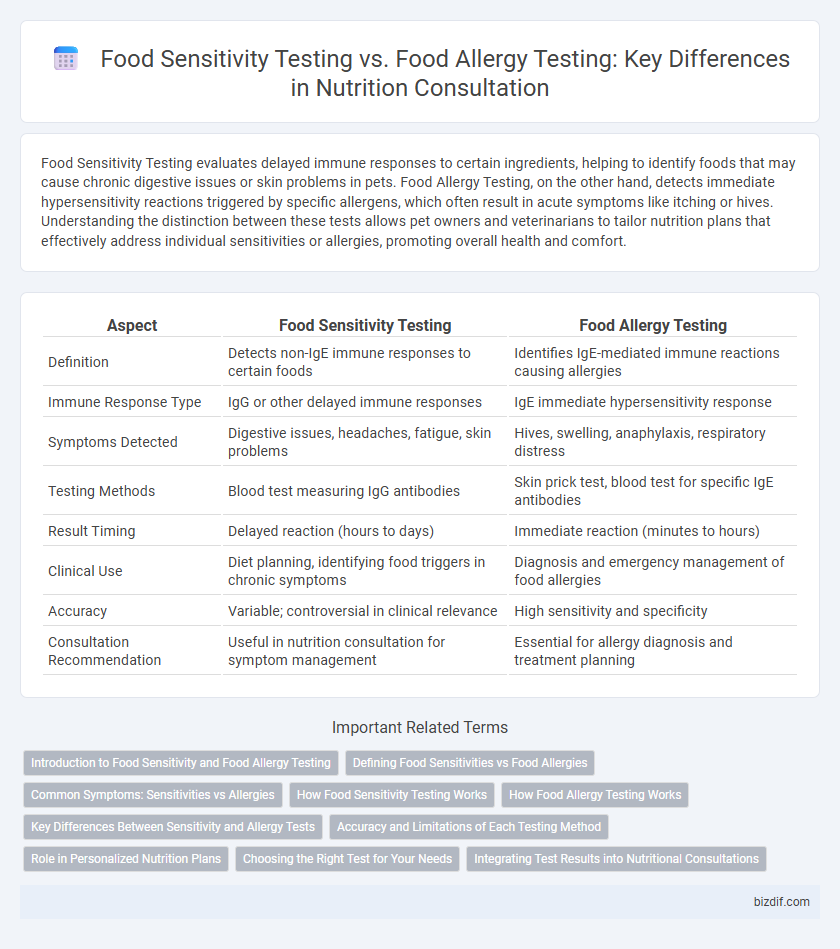Food Sensitivity Testing evaluates delayed immune responses to certain ingredients, helping to identify foods that may cause chronic digestive issues or skin problems in pets. Food Allergy Testing, on the other hand, detects immediate hypersensitivity reactions triggered by specific allergens, which often result in acute symptoms like itching or hives. Understanding the distinction between these tests allows pet owners and veterinarians to tailor nutrition plans that effectively address individual sensitivities or allergies, promoting overall health and comfort.
Table of Comparison
| Aspect | Food Sensitivity Testing | Food Allergy Testing |
|---|---|---|
| Definition | Detects non-IgE immune responses to certain foods | Identifies IgE-mediated immune reactions causing allergies |
| Immune Response Type | IgG or other delayed immune responses | IgE immediate hypersensitivity response |
| Symptoms Detected | Digestive issues, headaches, fatigue, skin problems | Hives, swelling, anaphylaxis, respiratory distress |
| Testing Methods | Blood test measuring IgG antibodies | Skin prick test, blood test for specific IgE antibodies |
| Result Timing | Delayed reaction (hours to days) | Immediate reaction (minutes to hours) |
| Clinical Use | Diet planning, identifying food triggers in chronic symptoms | Diagnosis and emergency management of food allergies |
| Accuracy | Variable; controversial in clinical relevance | High sensitivity and specificity |
| Consultation Recommendation | Useful in nutrition consultation for symptom management | Essential for allergy diagnosis and treatment planning |
Introduction to Food Sensitivity and Food Allergy Testing
Food sensitivity testing identifies non-immune reactions to specific foods, often causing digestive discomfort, headaches, or fatigue, while food allergy testing detects immune system responses involving IgE antibodies that can trigger severe reactions like anaphylaxis. Understanding the differences between these tests is crucial for accurate diagnosis and personalized dietary planning. Proper assessment through either ELISA for sensitivities or skin prick and blood tests for allergies ensures effective management of adverse food reactions.
Defining Food Sensitivities vs Food Allergies
Food sensitivity testing identifies non-immune-mediated reactions to specific foods, typically causing digestive discomfort, headaches, or fatigue, whereas food allergy testing detects immune system responses triggered by allergens, which can result in severe reactions like anaphylaxis. Food allergies involve the production of Immunoglobulin E (IgE) antibodies, leading to immediate hypersensitivity, while food sensitivities often involve delayed responses without IgE involvement. Accurate differentiation between food sensitivities and allergies is crucial for effective dietary management and avoiding adverse health effects.
Common Symptoms: Sensitivities vs Allergies
Food sensitivity testing often identifies delayed reactions such as digestive discomfort, headaches, and fatigue, while food allergy testing detects immediate immune responses like hives, swelling, and anaphylaxis. Sensitivities involve non-IgE mediated reactions causing chronic symptoms, whereas allergies trigger IgE-mediated reactions with acute and potentially life-threatening symptoms. Understanding the distinction between food sensitivities and allergies is crucial for accurate diagnosis and effective dietary management.
How Food Sensitivity Testing Works
Food sensitivity testing evaluates the body's delayed immune response to specific foods by measuring Immunoglobulin G (IgG) antibodies, helping identify potential triggers of gastrointestinal discomfort, headaches, or fatigue. Unlike food allergy testing, which detects immediate IgE-mediated reactions, sensitivity testing involves blood samples analyzed for reactions that may develop hours to days after consumption. This method supports personalized dietary adjustments to reduce inflammation and improve overall digestive health.
How Food Allergy Testing Works
Food allergy testing works by identifying specific immune responses to certain proteins in foods, typically through skin prick tests or blood tests that measure IgE antibodies. These tests detect immediate hypersensitivity reactions, which can cause symptoms ranging from mild hives to severe anaphylaxis. Understanding the immune system's response helps nutrition consultants tailor dietary recommendations to avoid allergens and manage allergic reactions effectively.
Key Differences Between Sensitivity and Allergy Tests
Food sensitivity testing identifies delayed immune responses typically mediated by IgG antibodies, revealing uncomfortable digestive symptoms without immediate danger. In contrast, food allergy testing detects immediate IgE-mediated reactions that may cause life-threatening symptoms like anaphylaxis, requiring urgent medical attention. Understanding these distinctions helps tailor personalized nutrition plans and avoid unnecessary dietary restrictions.
Accuracy and Limitations of Each Testing Method
Food Sensitivity Testing often uses IgG antibody detection, which may indicate delayed reactions but lacks consistent clinical validation and can produce false positives. Food Allergy Testing primarily relies on IgE antibody measurements or skin prick tests, providing high accuracy for immediate hypersensitivity reactions but cannot detect delayed food sensitivities. Both tests have limitations: allergy testing cannot identify non-IgE mediated sensitivities, while sensitivity testing may not reliably distinguish between tolerance and adverse reactions, emphasizing the need for comprehensive clinical evaluation.
Role in Personalized Nutrition Plans
Food sensitivity testing identifies non-IgE immune responses and digestive reactions to specific foods, providing detailed insights for personalized nutrition plans tailored to reduce inflammation and improve gut health. Food allergy testing detects IgE-mediated immediate hypersensitivity, essential for avoiding life-threatening allergens and ensuring safety in dietary recommendations. Integrating both tests enhances precision in dietary adjustments, promoting optimal nutritional outcomes and individualized wellness strategies.
Choosing the Right Test for Your Needs
Food sensitivity testing identifies delayed reactions to foods that may cause digestive discomfort, headaches, or fatigue, while food allergy testing detects immediate immune responses that can be life-threatening, such as anaphylaxis. Selecting the right test depends on symptom patterns and severity; patients with chronic, vague symptoms benefit from sensitivity tests, whereas those with acute reactions require allergy testing for accurate diagnosis. Consulting a registered dietitian or allergist ensures personalized assessment and effective management plans based on test results.
Integrating Test Results into Nutritional Consultations
Food sensitivity testing and food allergy testing provide distinct insights crucial for personalized nutrition plans. Integrating these test results allows nutrition consultants to tailor dietary recommendations by identifying both immune-mediated allergies and non-immune food sensitivities, improving symptom management and overall health outcomes. Utilizing comprehensive test data enhances the precision of elimination diets and supports targeted nutrient adjustments to address individual intolerances effectively.
Food Sensitivity Testing vs Food Allergy Testing Infographic

 bizdif.com
bizdif.com